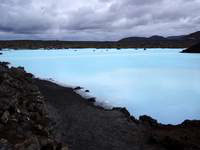
A favourite and unique attraction close to Reykjavik, about 30 miles (50km) southwest of the city, is the manmade geothermal Blue Lagoon. It is set in a lava field, filled with mineral-rich hot water pumped from about a mile below the surface. The lagoon is flanked by a luxurious health spa where visitors come to be pampered and treated for skin ailments like eczema and psoriasis. The lagoon's surreal phosphorescent aquamarine colour is caused by the therapeutic ecosystem of algae, silica, and minerals in the water. The Blueline bus company offers transport to and from the Blue Lagoon, and other transport options are outlined on the official website. Visitors should note that the Blue Lagoon is very popular and should be booked as far in advance as possible to avoid disappointment. The opening times change seasonally and can be found on the website listed below.
Address : 240 Grindavik, Iceland
Website : www.bluelagoon.com
Transport : Schedules buses are available from Reykjavik.
Opening times : Opening times are seasonal, but Blue Lagoon is generally open 8am to 9pm.
Admission : 6990 ISK for the Comfort package
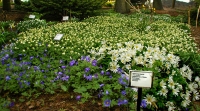
Although Iceland is better known for its stark and rocky landscapes, a walk in Reykjavik's gardens will convince travellers of the country's more lush and flowery offerings. The pretty Reykjavik Botanic Garden is a haven for strollers, enshrining about 5,000 plant species, including a large collection of Icelandic indigenous plants and other plant collections, which give an idea of the enormous diversity of vegetation in the northern temperate zone. Besides walking trails and water features, the garden has a display greenhouse where a cosy café is open during the summer months. Located close to the garden is the Reykjavik Zoo and Family Park. The gardens are open all year round, though opening times may vary season to season and there is less to see in the colder months. Admission is free.
Address : Laugardalur Valley 104
Website : www.grasagardur.is
Transport : Laugardalshöll bus stop is a short walk away.
Opening times : 10am-10pm during summer, 10am-3pm during winter
Admission : Free
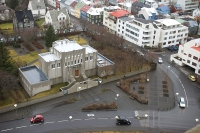
Einar Jónsson was Iceland's foremost sculptor, designing and establishing the Einar Jónsson Museum himself. It contains over 300 of his pieces, spanning his 60-year career, and served as his home, gallery, and studio. The building itself is deemed to be Jónsson's largest work, with the foundation stone laid in 1916. Iceland's first art museum, it retains pride of place on the highest point in Reykjavik. It is adjoined by a pristine and leafy sculpture garden, sporting about 26 bronze casts of the artist's work. There is also a museum shop selling plaster casts of Jónsson's works, books, and postcards. Travellers should note that the museum is closed on Mondays and for the whole of January and February. All other admission details can be found on the official website listed below.
Address : Eiriksgata 3
Website : www.lej.is/en
Transport : Snorrabraut bus stop is a short walk away.
Opening times : 10am-5pm Tuesdays to Sundays
Admission : 1000 ISK for adults, concessions available.
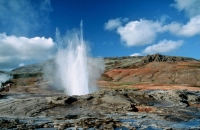
The weird landscape of the Haukadalur Valley in the southern lowlands of Iceland has been dominated for centuries by the Great Geysir. It's from here that all other such phenomena around the world have gained their name. The geyser once shot boiling water hundreds of feet into the air, but the height of the eruption has reduced in modern times. Nevertheless, it's still an impressive sight. The rest of the thermal area, bathed in a sulphuric smell, is just as fascinating, featuring several other spouting vents and geysers which frequently display their prowess. The Great Geysir has become a very popular tourist attraction, and a centre has been opened containing a multimedia geology museum and folklore exhibits. There is also a hotel, souvenir shop, and restaurant on site.
Address : Geysir Center, Geysir
Website : www.geysircenter.com
Transport : Situated on the Golden Circle tour route, or drive yourself.
Admission : Free
Iceland's famed Gullfoss (Golden) Falls are justly rated among the most beautiful in the world, and make for a popular excursion from Reykjavik. The falls, with their awesome double-cascade, are incredibly powerful, which has meant they have come under threat of being utilised as a source of hydro-electricity. Currently, however, the magnificent natural water feature, shrouded in mist and rainbows and gushing into a canyon on the Hvita River, is safely ensconced in a national park and remains one of the country's top tourist attractions. The falls can be visited on Iceland's famous Golden Circle route, and many tour operators and public buses make daily trips to the national park during the warmer months.
Address : Gullfoss National Park
Website : www.gullfoss.is
One of the tallest buildings in Iceland, this landmark church dominates the city from its highest point and is visible on a sunny day from up to 10 miles (16km) away. Named after the 17th-century Icelandic poet, hymn composer, and clergyman Hallgrimur Petursson, the church's unusual design includes volcanic basalt columns flanking its towering steeple. It took more than 40 years to build the edifice, which was finally completed in 1986. In front of the church stands a statue of Leif Eriksson, donated to Iceland by the United States. The church is lovely inside but even those uninterested in exploring this place of worship will be impressed by the striking facade. It is possible to climb the tower for views over the city.
Address : At the end of the Skólavörðustígur
Website : www.hallgrimskirkja.is
Telephone : 510 1000
Transport : Landspitalinn bus stop is a short walk away.
Opening times : Daily 9am-5pm (October to April) and 9am-9pm (May to September). Closed during Sunday mass.
Admission : ISK 1000 for adults, ISK 100 for children
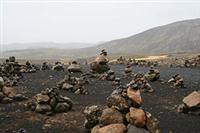
One of the most interesting cultural drawcards of Iceland must surely be the Huldufólk ('Hidden People'). In Icelandic folklore, the Huldufólk are magical invisible beings who can appear at will. Also called elves, they can be observed by humans with a talent for communicating with the hidden realm. While not many of Iceland's population believe in the Huldufólk, they remain an important element of the country's folklore and national identity. Visitors to Iceland who learn about the Hidden People will gain a lot of insight into local culture. Recommended Huldufólk-related activities include a visit to Reykjavik's Hellisgerdi Lava Park (which is supposedly full of elven homes); a trip to the Museum of Icelandic Wonders in Stokkseyri (just 37 miles/60km from the capital); and, for the really enthusiastic, a half-day course at Magnús Skarphedinsson's Álfaskólinn, the Icelandic Elf School, where you'll learn all about their world and even receive a diploma to prove it.
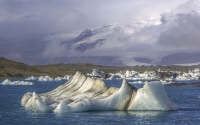
Jökulsárlón - literally, 'glacier lagoon' - is the largest glacial lake in Iceland, and an enormously popular tourist attraction. The site shot to prominence after being featured in Hollywood movies (most memorably, Batman Begins), and now attracts thousands of visitors each year. Caused by the retreat of the glacier known as Breiðamerkurjökull, the lagoon is now nearly a mile (1.5km) from the ocean's edge, and is over 814 feet (248m) deep. Most easily approached from the fishing town of Höfn on Iceland's southern coast, visitors in search of an indelible memory of their time in the country should definitely make the trip to Jökulsárlón, where luminous blue icebergs float eerily across the freezing water. Whatever you do, don't forget to pack a camera - Jökulsárlón is undoubtedly one of the best sights Iceland has to offer, and in such a staggeringly beautiful country, that's really saying something.
Website : icelagoon.is
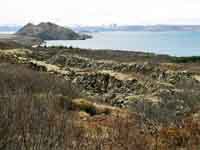
The national park of Thingvellir, 30 miles (50km) east of Reykjavik, is not only Iceland's most important historic site, but also a place of natural and geological wonder. It was here that the world's first-ever parliament, the Alting, initially convened in AD 930, and where Christianity was first introduced to Iceland. Even today, people gather at Thingvellir to celebrate any major national event. Geologically, this is the only site in the world where the American and European tectonic plates are visible. The park is also home to the largest lake in Iceland, and stunning scenery including a lava gorge, the Oxararfoss Waterfall, and the Money Chasm, where visitors drop coins down a gorge into water, to witness the strange distorted reflections that result. Activities available at Thingvellir National Park include hiking, angling, horseback riding, diving, and camping. The national park is open all year and in the warmer months a daily bus visits the park from Reykjavik.
Address : 801 Selfoss
Website : www.thingvellir.is/english

Travel Guide powered by Word Travels, copyright © 2023 Globe Media Ltd. By its very nature information in this travel guide is subject to change at short notice and travellers are urged to verify information on which they're relying with the relevant authorities. Neither Globe Media Ltd nor Travel Vogue can accept any responsibility for any loss or inconvenience to any person as a result of information contained above.